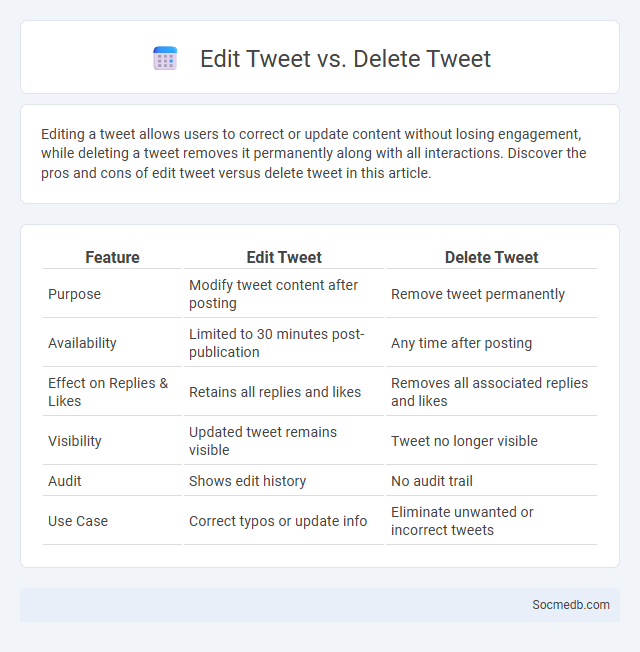
Photo illustration: Edit Tweet vs Delete Tweet
Editing a tweet allows users to correct or update content without losing engagement, while deleting a tweet removes it permanently along with all interactions. Discover the pros and cons of edit tweet versus delete tweet in this article.
Table of Comparison
| Feature | Edit Tweet | Delete Tweet |
|---|---|---|
| Purpose | Modify tweet content after posting | Remove tweet permanently |
| Availability | Limited to 30 minutes post-publication | Any time after posting |
| Effect on Replies & Likes | Retains all replies and likes | Removes all associated replies and likes |
| Visibility | Updated tweet remains visible | Tweet no longer visible |
| Audit | Shows edit history | No audit trail |
| Use Case | Correct typos or update info | Eliminate unwanted or incorrect tweets |
Understanding Edit Tweet: What It Means for Users
Editing a tweet allows users to modify their posts after publishing, enhancing clarity, correcting errors, or updating information without deleting the original content. This feature supports improved communication by enabling users to maintain accurate, relevant, and timely messages on platforms like Twitter. Understanding the edit history and character limits ensures users leverage this tool effectively while preserving transparency and engagement.
Delete Tweet Feature: How and When to Use It
The Delete Tweet feature on social media platforms allows you to remove outdated, incorrect, or sensitive posts quickly, maintaining your online reputation. Use this feature when a tweet contains errors, outdated information, or potentially harmful content that could affect your personal or professional image. Managing your tweet history by selectively deleting posts helps you control your digital footprint effectively.
Trending Topics Explained: Why They Matter on Twitter
Trending topics on Twitter capture the most discussed subjects in real time, reflecting the collective interests and urgent issues of a global audience. Understanding these trends helps you stay informed about breaking news, popular culture, and social movements, enabling timely engagement and meaningful conversations. Twitter's algorithm prioritizes content related to these trends, amplifying voices and shaping public discourse through user interactions.
Edit vs Delete: Key Differences and Use Cases
Editing social media posts allows users to correct mistakes or update information while preserving the original engagement and context, making it ideal for timely clarifications. Deleting posts removes content entirely from the platform, eliminating visibility and interaction, which is useful for sensitive or outdated information that may negatively impact reputation. Understanding when to edit versus delete hinges on factors such as content relevance, audience perception, and the permanence of online records.
Impact on Engagement: How Edits and Deletions Affect Tweets
Edits and deletions on tweets significantly influence social media engagement by altering user perception and interaction patterns. Edited tweets can clarify or update information, increasing retweets and likes by maintaining relevance, while deletions often reduce visibility and interrupt conversation flow, leading to diminished engagement metrics. Platforms like Twitter track changes to preserve transparency, but the immediate impact commonly reflects fluctuating audience trust and participation rates.
Trending Topics and User Interaction: Influence on Content Choices
Trending topics on social media shape content choices by driving creators to align posts with popular hashtags and viral conversations, increasing visibility and engagement. High user interaction metrics such as likes, shares, and comments signal platform algorithms to prioritize specific content, reinforcing its reach among target audiences. This dynamic feedback loop between trending subjects and active user participation significantly influences the type and timing of content production across social networks.
Pros and Cons of Editing Tweets
Editing tweets allows users to correct typos, clarify messages, and improve engagement, enhancing overall communication accuracy on platforms like Twitter. However, the potential for misuse, such as altering the original context or spreading misinformation after initial posting, raises concerns over transparency and trustworthiness. Balancing the benefits of message correction with the risks of content manipulation is essential for maintaining user confidence and platform integrity.
Risks and Benefits of Deleting Tweets
Deleting tweets can help protect your online reputation and reduce exposure to privacy risks, such as unwanted attention or misuse of personal information. However, removing tweets may also cause loss of valuable content that contributes to your digital identity and engagement with your audience. Carefully weigh the benefits of safeguarding your online presence against the potential impact on your social media influence and reach.
How Trending Topics Shape Conversation and Virality
Trending topics on social media serve as catalysts for widespread engagement, rapidly amplifying conversation across platforms such as Twitter, Instagram, and TikTok. Your participation in these trending discussions enhances visibility and drives content virality by tapping into real-time, collective interests and cultural moments. Algorithms prioritize trending hashtags and keywords, increasing the likelihood that your posts will reach a broader, more active audience.
Edit, Delete, or Ride the Trend: Choosing the Best Approach
Effective social media management involves deciding whether to edit content for clarity, delete outdated posts, or ride the trend to maximize engagement. Editing posts ensures accuracy and relevance, while strategic deletion maintains a positive brand image by removing irrelevant or harmful content. Riding the trend leverages current viral topics to boost visibility and connect with a wider audience, driving higher interaction rates and follower growth.
 socmedb.com
socmedb.com